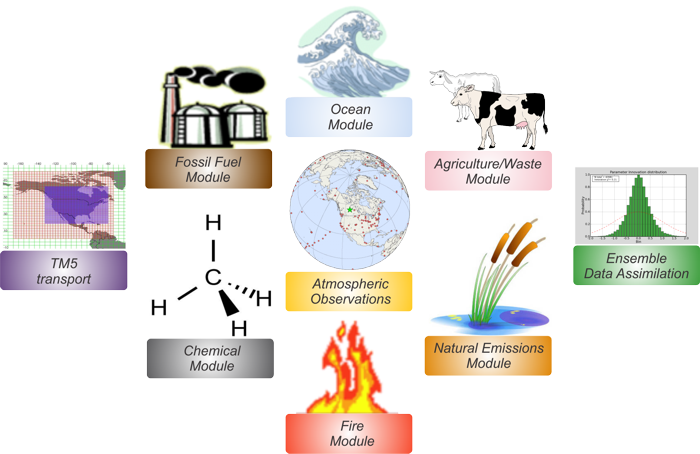Information
Home FAQ Project Goals Documentation Collaborators TutorialResults
Fluxes Observations Evaluation Visualization DownloadGet Involved
Suggestions E-mail List Contact UsResources
How to Cite Version History Glossary References Bibliography
To learn more about a CarbonTracker component, click on one of the above images.
Or download the full PDF version for convenience.
Chemistry
Introduction
Methane is removed from the atmosphere primarily by its reaction with the hydroxyl radical (OH), but also by its reaction with atomic chlorine (Cl) and excited-state oxygen (O1D) in the stratosphere. Closer to the surface of the Earth, in the troposphere, the average lifetime of methane is about a decade. The chemical loss of methane over a year is roughly equal to the total input from its sources (~520 TgCH4/yr). However, small differences in the total emissions and losses of methane, lead to trends in observed methane levels.
It is difficult to characterize the global distribution of OH because it is extremely reactive as well as having a short lifespan in the atmosphere. Instead, observations of atmospheric species that have relatively well-known anthropogenic sources and are destroyed only by reaction with OH, such as methyl chloroform (CH3CCl3) are used, often along with an atmospheric transport model, to estimate the abundance of atmospheric OH. Using an empirical approach, Montzka et al. (2011) noted that the inter-annual variability in atmospheric OH is likely to be within about ~2%. Errors in OH distributions arise from uncertainty in the sources of CH3CCl3 used to estimate OH, as well as uncertainties in transport models. Krol et al. (1998) estimates that the uncertainty of OH distribution is 10%.
About 10% of total chemical loss of methane is due to transport and chemical destruction in the stratosphere. A small amount of this methane-depleted air is returned to the troposphere, and can influence the interpretation of high-altitude (aircraft) measurements of methane. In addition, errors in simulating stratosphere-troposphere transport have the potential to produce biases for long term model simulations.
Errors in the chemical loss of methane, and the inability to adequately resolve inter-annual variability of OH, make the estimation of methane fluxes challenging. A 2% variation in the global methane sink is equivalent to ~10 TgCH4/yr, roughly the size of estimated inter-annual variability in methane sources. Currently, the best approach is to use OH fields that are as consistent as possible with existing records of species whose chemistry is significantly linked with OH. Examples include, carbon monoxide (CO) and methyl chloroform (CH3CCl3).
Detailed Description
For this version of CarbonTracker-CH4 we use pre-calculated OH fields from a global chemical model that have been optimized against global observations of methyl chloroform. The chemical loss fields consist of a single, repeating seasonal cycle, and result in a methane lifetime of about 9.5 years. Details of the chemical loss fields may be found in Bergamaschi et al. (2005). Currently CarbonTracker-CH4 does not attempt to adjust the global chemical loss through the assimilation of methane observations.
